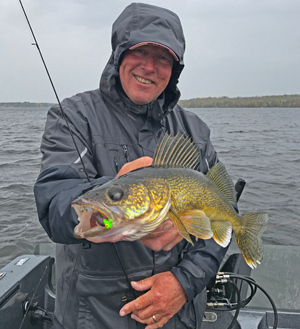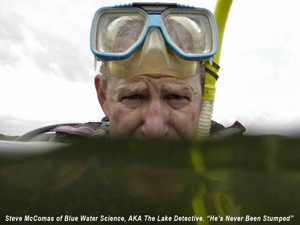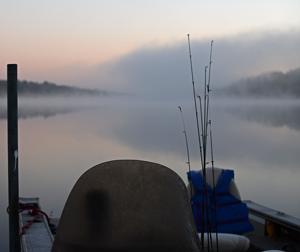
 By the time most folks have their boats tucked in for winter; a majority of Midwestern lakes still have not reached their “cold water turnover period” of the open water fishing season.
By the time most folks have their boats tucked in for winter; a majority of Midwestern lakes still have not reached their “cold water turnover period” of the open water fishing season.
Despite that nip in the late fall air, there’s lots of fishing still to be done, in fact for the hearty, catching fish in open water could keep a fisherman occupied all the way to freeze up.
One key to consistent catches of fish during late autumn lies in understanding how fish and their forage respond to falling water temperatures. Just because water temperatures turn cold, lakes turn over and fish disperse, doesn't mean that they won't feed or that they aren't catchable, they are.
During fall, many lakes undergo a transformation known as the fall turnover. Not every lake turns over, and the effects of turn over can't always be measured equally between lakes. Getting a handle on how fish respond to these transformations is what makes us better cold water anglers.
Your favorite lake might undergo a turnover, or it might not; depending on who you ask, getting an answer in simple layman's terms might be tricky, but before you can plan your fishing strategy, you do need to understand this piece of the puzzle.
For a general explanation, I relied on Steve McComas of Blue Water Science. McComas' twin cities based firm specializes in all things water. AKA "The Lake Detective", McComas, has rarely, if ever been stumped.
 In a message to McComas, I wrote; "In the lakes that do stratify and turn over, is there a precise temperature when one would expect a lake to undergo the fall turnover or is the relationship relative to underlying water temperatures?
In a message to McComas, I wrote; "In the lakes that do stratify and turn over, is there a precise temperature when one would expect a lake to undergo the fall turnover or is the relationship relative to underlying water temperatures?
McComas; "The quick answer is when the top water temperature is lowered to the underlying water temp, the lake can turn over.
To add a little back story, bottom water (the hypolimnion) is cold. The densest water is 4C or about 40F and many lakes have bottom water with that temp. That means the surface water has to cool down to 40F to get to the same density as the bottom water and then the whole water column will mix with a little wind action.
However, in some shallower lakes the bottom water may be a tad warmer than 40F, but still denser than the warmer top water. The same principle still applies, when the surface water temp is lowered to the bottom water temp, a little wind will mix the lake. Some lakes have turned over already; others will have to wait until the surface water temps get down to 40F and that might be a while".
Knowing this makes me think that most fishermen probably never actually fish during "The Turnover" and that means that the absolute scientific event is probably not the only thing that influences fish locations and feeding patterns during the cold water period.
Most of us rarely, if ever see surface temperatures colder than 40 degrees and for me, 50 degree water is enough to produce dramatic changes in both location and feeding patterns. In other words, it's the fish that force me into finding alternative locations and feeding patterns well before the scientific version of turnover actually occurs.
 Although there are times when a lake make may actually have completely turned over during our fishing season, it seems more likely to me that it's fish metabolism, the loss of shallow water weed cover and the influence of moving forage that determines where the fish will be and how easily they can be caught.
Although there are times when a lake make may actually have completely turned over during our fishing season, it seems more likely to me that it's fish metabolism, the loss of shallow water weed cover and the influence of moving forage that determines where the fish will be and how easily they can be caught.
After reading between the lines of the Lake Detective's answer, it seems more likely that what we anglers really experience are "Mini-Turnovers". Times when the exchange of surface water and the denser bottom water is not driven solely by surface temperature.
In shallow water for example, strong winds could provide adequate current to roll over the entire water column, but still not produce enough current to thoroughly mix the water in a deeper portion of the same lake.
For me, there's a definite moment during fall when the fish make it absolutely clear that they have changed their patterns. There's still no doubt in my mind that we need to consider the effects of cooling water, but maybe we've been calling it by the wrong name. Maybe we need to start calling it something like "seasonal feeding disorder"?
Leaving the realm of scientific data, it's my own anecdotal experiences that tell me when we're in the period that I used to refer to a "post-turnover". During this period, there are two productive patterns that keep popping up.
Fishing Crepuscular Periods: For me, there's almost always a week or two when the fishing, especially for Walleye is much better during low light periods than it is during the daylight hours. Cloudy days with plenty of breeze are an exception, they produce "low light" conditions and I take them as a bonus. But when I'm fishing on a brighter, calmer day, I'm frequently using the daylight hours primarily to locate fish and calculate where I want to be set up for the evening bite.
There have been many late fall fishing trips when it was the last hour of daylight that made our whole day. So if you were planning a late fall fishing trip, sleeping in during the morning and being sure to stay on the lake until dark could pay off bigtime.
Finding Baitfish That Return To Shallow Water: During fall, Salmonids like Tulibee and Whitefish move toward the shoreline to spawn. Most of the spawning activity occurs at night, on shallow stretches of gravel and light rock.
While these fish are present, large predators like Pike, Musky and big Walleyes move onto nearby shoreline breaks. Smaller baitfish like young of the year Perch, Shiner Minnows and others also move toward the shoreline, most of their time is spent hovering over weed tops. On sunny days they will run into shallow water, temporarily inhabiting sand beaches where the warm sunshine works its magic.
Knowing where there are expanses of healthy green weeds will help you calculate where these swarms of baitfish will be hiding. Catching fish becomes like hunting, it boils down to targeting the breakline areas between the weeds and shallow water where baitfish will move in or out depending on conditions.
Why wish the fall away? Whatever we choose to call it, fishing during the cold water period is an awesome way to spend a day and I'm gonna get as many of them in as I can. Put the boat away? Heck, I can do that while I'm waiting for the ice to get thick enough to walk on!
Comments, Questions? Email
Home | Current Fishing Report | Saved Fishing Reports | Favorite Lakes | Fishing Articles Section | Recipes | Rates Services | Gift Certificates | Contact | For Sale | Links | Sitemap |
"The Early Bird Fishing Guide" Jeff Sundin - Fishing Blue Books, LLC 715 Byington Ave, LaPrairie, MN 55744 218-245-9858
Email copyright©2020 Fishing Blue Books, LLC All Rights Reserved - last revised 08-20-2020